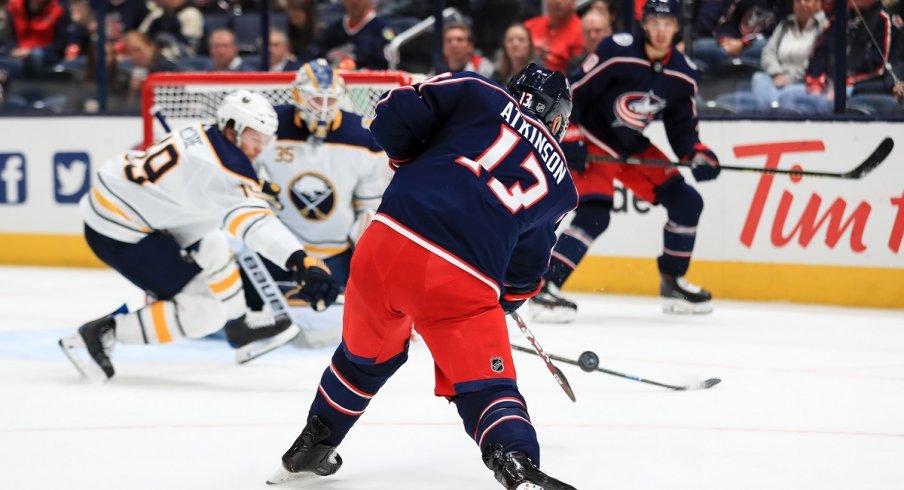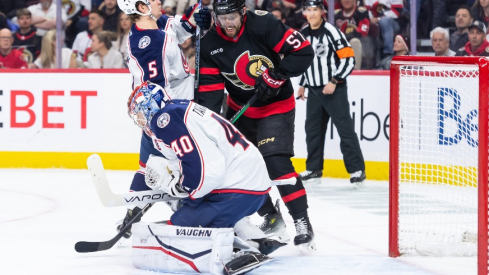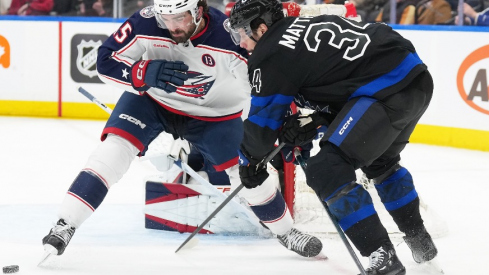Yes, It's early, but the Columbus Blue Jackets power play is clicking.
The club has scored on three of its nine opportunities and appears well-positioned with the man-advantage despite the loss of some key players (you may have heard about them).
The top power play unit, featuring Seth Jones, Pierre-Luc Dubois, Cam Atkinson, Alexander Wennberg, and Gustav Nyquist has been responsible for two of the three goals, while the second unit, icing Zach Werenski, Oliver Bjorkstrand, Nick Foligno, Alexandre Texier, and Emil Bemstrom scored the third period, go-ahead goal in Monday's 4-3 OT win over the Buffalo Sabres.
In this year's first Film Session, we'll break down what has made the Blue Jackets power play successful to start the year.
Once a team's power-play unit has set up in whatever formation it fancies, there are a few key themes that all teams try to accomplish. The first is the idea of moving the puck from one side of the ice to the other. Not only does it force the four penalty killers to re-adjust and move, but it also forces the goaltender to move side-to-side, where they're much more vulnerable.
Being able to move the puck quickly and in unpredictable routes puts the penalty killers in a difficult spot, as there simply aren't enough players to cover all attackers.
Second is the idea of isolating a defender to create miniature 2-on-1s all over the ice. Similar to the first concept, the idea here is to put stress on the opposition, forcing them into a position where they can't win.
Lastly, and building off Point No. 2, is the idea of always out-numbering your opponent. When the bad guy gains possession of the puck, it means hounding him with two of your forecheckers. When there's a 50-50 loose puck in front of the net? Out-number the opponent at the point of attack.
So far this season, the Blue Jackets have been excellent in all three of these concepts. The first goal I want to examine is Foligno's (at the time) go-ahead goal in Monday night's win over the Buffalo Sabres, the second unit's first power-play goal this season.
If you freeze it at the 0:15 mark, you'll see that Bjorkstrand correctly identified that the Sabres aggressive penalty kill momentarily had three killers at or above the face-off dot, meaning the Blue Jackets had (at worst) a 2-on-1 in front of the net. As there was a stick in the passing lane, Bjorkstrand does what he knows best: firing the puck. At 0:17, you'll notice a 3-on-2 scrum has developed, with Foligno and Bemstrom joining the fray. By the time the Sabres kill collapses to match the Blue Jackets numbers, Foligno found the loose puck and capitalized on the chaos. Simple math on this big goal.
Next up is Atkinson's goal that made it 2-0, Blue Jackets.
The Blue Jackets utilize a 1-3-1 power-play formation, with Jones the "high 1", Dubois and Atkinson the flanks and Nyquist the bumper (more on that in a few paragraphs), and Wennberg the "low 1".
At 0:10, the 1-3-1 is easily recognizable. Dubois has the puck and realizes that his only viable options are a drop-pass back to Jones (a bit risky but he could do it given his defender's stick position), a low-percentage shot, or a pass down low to Wennberg. The Sabres do a good job clogging the middle of the ice, not allowing a pass to the bumper (Nyquist) or a cross-ice pass to Atkinson.
As soon as Dubois sees Wennberg become available as the option, it triggers a set play that we've seen before (from last year - 0:05): Atkinson inching down low for an opposite side slide. He catches all four Sabres watching the puck, as you can see easily at 0:44. Right before that at 0:43 is the last concept I mentioned earlier, which is isolating a defenseman and creating a 2-on-1. Dubois makes Rasmus Ristolainen (#44) pick between him and Wennberg. When he picks Dubois, he simply slides it to Wennberg, who knows the play to Atkinson on the back door is all-systems-go. Similarly, Wennberg isolates Jake McCabe (#19), creating a 2-on-1 from behind the net, putting his goalie in a precarious spot. Atkinson does with Atkinson does: score goals. It's a beautiful play that we can expect to see again.
The reason a good power play is so difficult to defend is the options the man-advantaged team has at their disposal. What if the Sabres would have done a better job defending Atkinson, spreading out a bit more? The Washington Capitals have tortured teams for years with just that scenario. Want to shadow Alexander Ovechkin? No problem, we'll make you pay with T.J. Oshie, one of the best bumper players in the NHL. The Blue Jackets are hoping that Nyquist can be that guy for them this year, and he nearly scored his second goal of the game the other day.
First, a look at Oshie. Similar to the Blue Jackets' top unit, the Capitals run a 1-3-1 and have for years. This goal from 2017 shows Oshie finding 'soft ice', a spot in a dangerous area where you're ever so slightly out of a defender's reach.
At 0:05, Oshie appears to be covered by two Penguins defenders. From 0:01-0:04, watch him search for that soft ice. A beautiful pass from Nicklas Backstrom, one of the best down-low passers in the NHL (and hopefully a player Wennberg can emulate) finds Oshie, who makes no mistake.
The bumper position is a unique spot in the middle of a 1-3-1 power play. It's called a bumper as the player can easily re-direct the pass right where it came from, like a bumper in bowling. This player is a facilitator and a distributor, who is also available for high tips and screens. Having a player who can also shoot from this spot is what makes it lethal. Nyquist didn't score on this play, but it's interesting to see the Blue Jackets try to utilize his skill set in this position.
At 4:30, watch how Dubois once again isolates Ristolainen (#44) in order to send a low pass to Wennberg. The difference is that instead of Wennberg going around the net for a shot to Atkinson (who, you'll notice at 4:32 is ready for that set play again), Wennberg threads a quick one-touch pass into soft ice between the two Sabres' defenders. At 4:39, you'll notice that if Nyquist puts a little bit more lift on that shot, he has himself a goal.
Even though Nyquist didn't score, it's still encouraging for the power play. After that play, the Sabres killers know that they cognizant of him as a player who could be a trigger on the power play, as well as Atkinson.
With two elite quarterbacks in Jones and Werenski, some sharpshooters in Atkinson, Bjorkstrand, Texier, and Bemstrom, and facilitators like Wennberg and Nyquist, the Blue Jackets power-play could be a real asset going forward.


